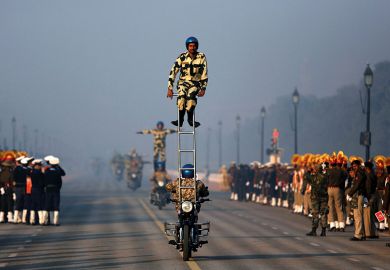Neither economic heft nor being a knowledge society are new to India. As one of the most ancient civilisations on earth, India developed a tradition of education five millennia ago and boasts the oldest university in the world, Nalanda University, which was built in the 5th century BC.
India was a leading economy for the majority of the past 2,000 years; it was only in the 19th and 20th centuries that India’s economic and education indicators declined sharply, with only approximately 70 per cent of the country literate today.
Now in the 21st century we are witnessing India’s rise. While its growth rate may have slowed in recent years, India is undeniably on the precipice of global economic superpower, predicted to emerge as one of the top three economies in the coming decades, alongside China and the US.
However, India still has many steps to take before it re-emerges as a knowledge power alongside modern-day heavyweights.
To benefit from its population size, India must respond to a twofold need: accessible and inclusive education to improve literacy and employability and a reduction in gender, caste, class and religion inequalities; and to establish a strong research culture.
The Draft National Education Policy 2019, published last year, is central to this vision. The plan was informed by one of the most consultative processes any policy draft has undergone, attracting more than 275,000 individual submissions.
The draft policy would introduce a transformative research culture into India’s tertiary sector that would secure its place as a global leader in knowledge creation. Investment in research would allow India to leap from frugal innovator – tweaking foreign inventions for use at affordable scale – to developments in pure, foundational research.
Alongside strengthening science, the draft policy also argues for the cultivation of cultural identity and ethical responsibility. It aims to promote India’s roots in the liberal arts, Ayurveda, languages, ethics and spirituality and highlights the importance of ethical leadership in pressing global challenges.
The draft policy will create three streamlined tertiary institution categories: research universities; teaching and research universities; and pure teaching universities. This would institute a culture of research in the highest performing, research-productive institutes while ensuring a stronger pedagogical focus for teaching universities.
The Indian government intends to establish 20 Institutes of Eminence that will include 10 public and 10 private universities. These universities will, among other things, benefit from greater autonomy to form partnerships with global universities. The government envisions that these will become leading and globally ranked institutions, the equivalent of Australia’s Group of Eight, the US Ivy League or the UK’s Russell Group.
However, unlike these groups thatwere formed independently by the universities themselves, India’s efforts more closely mirror China’s deliberate government initiative to establish the Chinese C9 League to promote the development and reputation of Chinese research quality.
China now has three universities in THE’s global top 100 (two in the top 30) and 17 in the top 500 compared with India’s six, with the highest-ranked Indian Institute of Science sitting in the 301-350 band.
Funding will be essential to India’s climb up the global tables. The draft policy proposes establishing a National Research Foundation that will cover four major pillars: sciences, technology, social sciences and arts and humanities.
Increasing research capacity will depend on international collaboration. The draft policy recommends fostering stronger links with foreign universities, including encouraging the top 200 globally ranked universities to operate a physical presence in India.
We have already seen collaborations between leading institutions in India and Australia including the the IIT Bombay-Monash Research Academy, which facilitates bilateral research in clean energy, water and biotech; the University of Queensland and IIT Delhi Academy of Research, which will provide for joint PhDs in fields that promote a resilient environment and respond to the needs of future smart cities; and the University of Melbourne’s Blended Science Program with Savitribai Phule Pune University that offer joint bachelor degrees in science fields. This trend is set to continue.
Funding has also been proposed for inward mobility scholarships to increase the number of international students studying in India, and to establish India as an international education hub. A push to recruit international faculty will ideally result in a richer research culture and encourage interdisciplinarity.
In the past five years, joint state and federal spending on education has gone from 3.8 per cent of GDP to 4.6 per cent, with a target set for 6 per cent in the future. If implemented, the draft policy would position India as a knowledge power of the 21st century.
Tanya Spisbah is director of the Australia India Institute. She is also a keynote speaker at the Times Higher Education India Universities Forum running from 16-17 January 2020.
Register to continue
Why register?
- Registration is free and only takes a moment
- Once registered, you can read 3 articles a month
- Sign up for our newsletter
Subscribe
Or subscribe for unlimited access to:
- Unlimited access to news, views, insights & reviews
- Digital editions
- Digital access to THE’s university and college rankings analysis
Already registered or a current subscriber?




